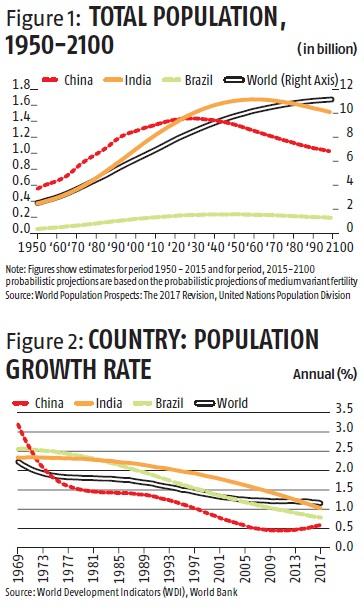What is the issue?
Experience at the global level shows that population growth, GDP growth and poverty reinforce one another.
What does the population growth data reveal?
- In the 2020s, India will overtake China’s population (at a time when the latter’s population will crest) and remain so to the end of the century.

- This is because, from a higher rate of population growth than India’s in 1960s, China began to reduce it stringently.
- From the beginning of the 1970s, China’s population growth rate fell below India’s and remained so thereafter.
- Thus, even though India was on a steadily declining trend throughout, China’s population growth rate was crashed to below that of India and that difference in growth rates increased.
- Only in the last few years, China’s population growth rate has picked up again as a deliberate policy, nevertheless remaining below India’s.
How does population growth link with GDP growth?
- China’s per capita GDP growth remained significantly above that of India since 1960s.
- But, in the last couple of years, India’s per capita GDP growth has crossed China.

- This reflects China’s recent relaxation of its population policy (increase in population) after half-a-century of control.
- Also, India’s steady increase in its GDP growth is witnessed along with the slowly declining population growth rate from the beginning of the 2000s.
- This shows that population growth and per-capita GDP growth are closely associated at both the domestic and the global level.
Can lower fertility rate lowers poverty?
- Fertility rate is the average number of live births per woman.
- Up to 2020, India’s rate of decrease in fertility parallels that of Brazil.
- But because of India’s higher base fertility levels, there is higher population growth in India than Brazil now.
- China kept down its fertility rate, which remained much lower than both Brazil and India.
- However, all three countries will have much lower fertility rates compared to the world average in the future.
- Nevertheless, India’s base population being high, its population will reach at some 1.6 billion in the 2060s, serving as the highest populated country.
- With that higher population, India will have challenges in income distribution and controlling poverty, since this could not represent a demographic dividend that India enjoys now.
- Thus, these observations emerge from a comparison of Brazil, China and India shows that population, GDP and poverty are inter-linked.
Source: Business Standard

